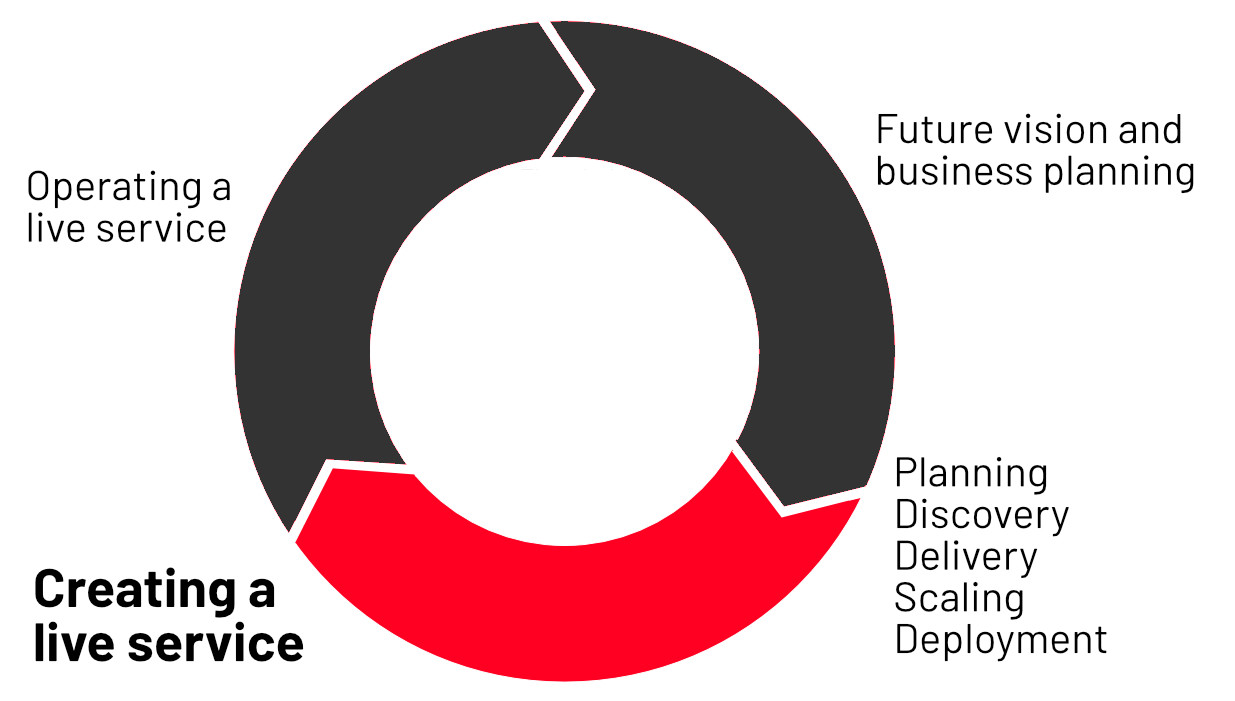Creating a live service
The development stage of our digital lifecycle for products and service, creating a live service involves five distinct stages, each using defined user needs and business goals, and Agile and iterative practices.

The stages
Our working principles come into play throughout the service creation phase. The principles promote constant user focus, collaboration, evidence-based decision making and more.
For example, it’s never taken for granted the service will be completed. At the end of each phase, we assess whether the activity continues to be useful. If an activity is unlikely to meet our goals, we stop.
Another example: The teams creating products and services, the teams operating the underlying business operations (data, fulfilment) and the devolved teams operating live services need to work closely together during development. They should integrate when useful, so that the devolved team can take full ownership when it’s added to our portfolio of live services and products.
In the future, we’ll formalise how we assess products and services at the end of each stage. The stages are:
1. Planning
This is when we’ll assess the impact and estimate the effort involved in the work. We'll commit to the highest priority ideas to put forward for discovery.
The ideas we take forward will go through a process involving:
roadmapping the product delivery
alignment with organisation goals and other plans
identifying the problem that needs to be solved and clarifying objectives
formulating a goal for the discovery
articulating a hypothesis the discovery needs to answer
planning the reporting
decide success criteria
prioritising proposed work based on user value and business goals against team capacity
2. Discovery
The discovery takes place to reduce uncertainty, so the right product or service gets built to meet the goal and fit the audience.
Product teams and stakeholders have a wide array of tools to use in a discovery, depending on the questions that need answering and the level of insight needed to move forward. These tools typically include:
audience research - demographics, geographic, size, digital behaviours and trends
user needs analysis - interviews, observational research, journey mapping and more
writing and prioritising user stories
defining and testing assumptions
competitive analysis
risk analysis
legal and policy parameters
identifying technology and knowledge gaps
ideation including lo-fi designs (wireframes, sketch designs, etc)
Multi-team workshops are a great way to achieve many of these, whether it’s a kickoff workshop, assumption-mapping session, service blueprinting workshop or more.
In the future, we’ll formalise how we assess products and services at the end of each development stage, to decide if they’re ready to move to the next stage.
3. Delivery
Broadly speaking, the delivery stage is when the solution is designed and built through a series of Agile sprints. Common elements include:
UX, front end and back end designs
content design
information architecture
spikes to test unknowns
building a prototype or minimum viable product (MVP)
user testing
QA
In the future, we’ll formalise how we assess products and services at the end of each development stage. At the end of the delivery stage, we need to assess whether an application, service or product is of a good enough standard to go live to our users, by the criteria we have agreed organisationally.
4. Scaling
Scaling is when we ensure the product or service we’re building is robust, stable and secure enough to serve the users it’s intended for.
Standard tactics at this stage include:
gathering user feedback
measuring and adapting
penetration testing
finding unexpected uses
repeated iterations, tested
bug fixing
building additional features
any organisational shifts - structure, capacity
In the future, we’ll formalise how we assess products and services at the end of each development stage. At the end of the scaling stage, we need to assess whether an application, service or product is robust and sustainable enough to deploy.
5. Deployment
The commonly understood definition of deployment is ‘to go live’. Yet what often gets missed in this definition is the full scope of everything that needs to go live.
The new product or service needs to launch on its intended platform. But so does every output related to the launch - processes, communications, events, product support and more.
A standard deployment includes:
soft launch or hard launch
ongoing user feedback
ensuring any tracking is working and compliant
launching any related systems or features
staff training
In the future, we’ll formalise how we assess products and services at the end of each development stage. At the end of the deployment stage, we need to assess how well all criteria have been met in order to launch.
Other lifecycle phases
Future vision and business planning
Contact us about the digital framework
Have a question or comment? Found a bug? Or maybe you’d like to contribute to the framework? Use our contact form to get in touch.
